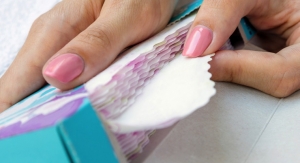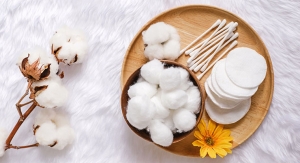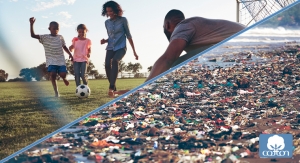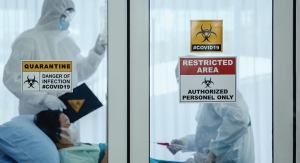Karen McIntyre, Editor11.02.18
Outlook 2018 was held October 17-19 in Dubrovnik, Croatia. The largest edition of Outlook since its inception in 2002, the event attracted more than 500 delegates from around the world. Unsurprisingly, lifecycle assessment, the European Union’s plastics directive, recyclability and other green-minded issues got top billing at the event, which is considered one of the world’s premier nonwoven personal care and hygiene product conferences and is organized by EDANA, the voice of nonwovens.
“This edition of Outlook has again featured, as deliberately planned these last few years, a very topical programme, directly addressing the current challenges in our industry, “says Pierre Wiertz, General Manager of EDANA. “Discussions on the circular economy strategy, transparency and trust in the supply chain were both thought-provoking and rewarding. It is very encouraging to witness the industry’s increasing readiness to engage in these topics and for EDANA to facilitate constructive dialogue on both strategic and practical solutions.”
Day one of the event began with a keynote presentation on the EU Circular Economy and Plastics Strategies and their Impact on the Absorbent Hygiene Products Industry, from Werner Bosmans, Coordination Plastics Strategy, DG Environment, European Commission. According to Bosmans, European plastics demand is now estimated at 49 million tons with packaging representing the largest segment at 40% by volume as well as the highest waste contributor at 59%. To combat plastic’s impact on the environment, the EU is seeking smart, innovative and sustainable solutions to curb waste and littering. Among these solutions will be higher quality plastic recycling programs to ensure that all plastic is either recyclable and reusable by 2030. This will require global action and multilateral initiatives, says Bosmans, such as international standards and cooperative funding.
This keynote speech was followed by a Circular Economy and Sustainability Session, which featured a presentation from Kirsi Seppälainen, vice president of strategic projects at Stora Enso who discussed how using fluff pulp and other wood-sourced materials in the place of fossil fuel-based products can not only create a product meeting demands for lower environmental impacts and natural ingredients but can offer innovation throughout the entire supply chain.
Keeping up with the theme of a lower environmental impact, Massimiliano Schietroma, of Fater SMART, provided an update on his company’s efforts in diaper recycling. Fater, which is a joint venture company of Procter & Gamble, has put into operation an industrial scale diaper recycling plant capable of recycling 10,000 tons of diaper materials per year in North Italy. Fater first began recycling diapers on a pilot scale in 2013 and expanded into industrial production in 2017. According to Schietroma, the next step is the establishment of an international consortium with 13 partner companies representing seven countries, which will spend five years looking at end of life solutions for cellulose waste, including diaper materials.
Other green-minded developments discussed at Outlook include a presentation on the flushability of Lyocell fibers when used in wipes from Lenzing’s Stefanie Schlager and a discussion on flushable wipes capacity in terms of market demand opportunities from Jonathan Bourget, managing director of Apis REX.
Day two of the conference began with a second keynote presentation. Professor Samuele Furfari of the Free University of Brussels discussed “The Changing World of Energy and Petrochemical Feedstocks.” Furfari discussed the world’s energy needs as they relate to demand and suggested that fossil-based energy is the preferable option over more sustainable options like solar and wind-generated energy because of consistency. “It’s impossible to produce electricity without using it,” he says. “By introducing intermittent energy generation, you complicate things and drive prices up.”
He adds that the wind only blows 23% of the time while the sun shines only 11% of the time, so relying on them remain difficult.
Meanwhile, new technologies have made generating oil and natural gas more efficient, driving up supply of these reserves around the world. “Engineers are leading the change in energy,” he says, noting that regulations in Europe have led the region to lag in these developments and prices have been impacted.
As for the plastics directive, Furfari says that education, not regulation, is the key to solving this problem. Demand for plastics has grown faster than any other bulk material in the world,” he says. “And, demand is 20 times higher in wealthier countries. Usage is growing higher than the GDP so demand will only increase.”
Thursday’s first session looked at changing market data, beginning with a look at the local Southeast European market from Violeta, a Bosnian manufacturer of disposable hygiene products. Slovenia, Croatia and Serbia represent the largest markets in the region and babies represent only 5% of the population in these countries, according to researcher Danijela Alilovi. Additionally, this economy is considered in transition meaning it is not mature and there is less competition. Alilovi looked at the major brands and their place in the major countries, noting that the market was inhabited by a mix of multinationals like Procter & Gamble and local producers like Violeta and Helen Harper as well as private label companies.
Also speaking in the Market session was Nonwovens Industry publisher Matt Carey, whose presentation Information Trends in Nonwovens (& Elsewhere) examined the changing role of data in our communication environment. Noting that 90% of all data generated in the history of the world was created in the past two years, he discussed how this surge has influenced, and deceived, audiences globally.
Other topics in the Market session were Key Parameters Effecting ADL Adhesive Bonding Performance on Baby Diapers, from Selda Colak Akbasli of H.B. Fuller and Advances in Sustainable Absorbents for the Hygiene Industry from Tyler Tibbits, vice president of sales and marketing for Tethis.
The Thursday afternoon Testing session featured An Investigation of Laboratory Test Methods for Predicting the In-Use Leakage Performance of Incontinence Pads in Nursing Homes from Alan Cottenden, Emeritus Professor Incontinence Technology at University College in London, U.K. According to Cottenden, the product characteristic most valued by caregivers in nursing homes is anti-leakage, a parameter that must be judged in real use. However, these types of evaluations are difficult, expensive and time consuming so for the past three decades, different agencies have been working toward coming up with a standard for assessing leakage in adult incontinence items. For years, the most accurate of these, the Rothwell method was developed in 1993 and updated in 2000. It has a product soak for 30 minutes and then drain for five minutes.
More recently, a new entrant, the Absorption Before Leakage (ABL) test method, has emerged as a potentially better method. It delivers normal saline until leakage and then subtracts dry weight from wet weight to give the ABL, and while the ABL has great potential as an international standard, the repeatability and reproducibility need to be improved.
Building on Cottendon’s speech was a presentation from Jens Hellmold, from Ontex, which provided an update on ISO test methods of absorption products. He outlines the challenges that have been discovered in replacing the Rothwell Method with the ABL. Key challenges include variation, a high level of training, time and time consuming but the benefits are that it considers a relevant design features reflects application to a human body through the use of a mannequin and simulates liquid intake.
Other testing-related presentations included: The Spin Finish—A Question Mark in Absorbent Hygiene products from CHT Germany and a State of the art of Odor Testing with a Specialty Focus on the Hygiene Industry from Olfasense.
The highlight of the Process session on Thursday afternoon was the presentation by Ingo Mahlmann, vice president of Oerlikon Nonwoven, during which he outlined a recent agreement between Oerlikon to develop cost-effective, high quality spunmelt manufacturing lines. The agreement combines the manufacturing expertise of Shaoyang Textile Machinery with Oerlikon’s engineering experience and its knowledge of the global nonwovens market.
Outlook concluded with an Interactive Workshop on Building Stakeholder Trust in Absorbent Hygiene Products. This session highlighted efforts, both within the industry and among government agencies, to assess the presence of hazardous substances in absorbent products and offer greater transparency.
Among the speakers was Ruth Steinholtz, founder and principal of AReteWork LLP, who presented Ethical Business Practice and Ethical Business Regulation. She discussed the use of the Cultural Values Assessment (CVA) tool which allows you to identify core values based on a proven model and verifying that these core values are aligned with personal values of your employees and their future. “By building cultural capital across the sector, you hold each other to account and work with human behavioral tendencies, not against them,” she says.
Amanda Rosen, inspector, Enforcement of Rules—Pesticides and Articles, KEMI Swedish Chemicals Agency, presented findings from a recently completed survey of hazardous chemical substances in feminine hygiene products.
This effort included the assessment of 35 products including pads, panty liners, tampons and menstrual cups using chromatography. While formaldehyde was found in all of the pads, liners and tampons assessed and abietic acid was found in all the liners, the agency found that the health risks associated with the use of feminine hygiene is low.
Meanwhile, Thomas Brock of Fibertex Personal Care, and Bart Waterschoot of Ontex Personal Care discussed EDANA efforts to create a code of good practice. In effort to hold onto customer trust, the Substance of Interest Task Force is developing a charter of safe and acceptable levels of SOIs in finished products to help manufacturers make safe AHPs.
“The consumers are looking at the experts to help them,” Waterschoot says. “It’s always important we listen to what the consumer says—even the most extreme ones.”
“This edition of Outlook has again featured, as deliberately planned these last few years, a very topical programme, directly addressing the current challenges in our industry, “says Pierre Wiertz, General Manager of EDANA. “Discussions on the circular economy strategy, transparency and trust in the supply chain were both thought-provoking and rewarding. It is very encouraging to witness the industry’s increasing readiness to engage in these topics and for EDANA to facilitate constructive dialogue on both strategic and practical solutions.”
Day one of the event began with a keynote presentation on the EU Circular Economy and Plastics Strategies and their Impact on the Absorbent Hygiene Products Industry, from Werner Bosmans, Coordination Plastics Strategy, DG Environment, European Commission. According to Bosmans, European plastics demand is now estimated at 49 million tons with packaging representing the largest segment at 40% by volume as well as the highest waste contributor at 59%. To combat plastic’s impact on the environment, the EU is seeking smart, innovative and sustainable solutions to curb waste and littering. Among these solutions will be higher quality plastic recycling programs to ensure that all plastic is either recyclable and reusable by 2030. This will require global action and multilateral initiatives, says Bosmans, such as international standards and cooperative funding.
This keynote speech was followed by a Circular Economy and Sustainability Session, which featured a presentation from Kirsi Seppälainen, vice president of strategic projects at Stora Enso who discussed how using fluff pulp and other wood-sourced materials in the place of fossil fuel-based products can not only create a product meeting demands for lower environmental impacts and natural ingredients but can offer innovation throughout the entire supply chain.
Keeping up with the theme of a lower environmental impact, Massimiliano Schietroma, of Fater SMART, provided an update on his company’s efforts in diaper recycling. Fater, which is a joint venture company of Procter & Gamble, has put into operation an industrial scale diaper recycling plant capable of recycling 10,000 tons of diaper materials per year in North Italy. Fater first began recycling diapers on a pilot scale in 2013 and expanded into industrial production in 2017. According to Schietroma, the next step is the establishment of an international consortium with 13 partner companies representing seven countries, which will spend five years looking at end of life solutions for cellulose waste, including diaper materials.
Other green-minded developments discussed at Outlook include a presentation on the flushability of Lyocell fibers when used in wipes from Lenzing’s Stefanie Schlager and a discussion on flushable wipes capacity in terms of market demand opportunities from Jonathan Bourget, managing director of Apis REX.
Day two of the conference began with a second keynote presentation. Professor Samuele Furfari of the Free University of Brussels discussed “The Changing World of Energy and Petrochemical Feedstocks.” Furfari discussed the world’s energy needs as they relate to demand and suggested that fossil-based energy is the preferable option over more sustainable options like solar and wind-generated energy because of consistency. “It’s impossible to produce electricity without using it,” he says. “By introducing intermittent energy generation, you complicate things and drive prices up.”
He adds that the wind only blows 23% of the time while the sun shines only 11% of the time, so relying on them remain difficult.
Meanwhile, new technologies have made generating oil and natural gas more efficient, driving up supply of these reserves around the world. “Engineers are leading the change in energy,” he says, noting that regulations in Europe have led the region to lag in these developments and prices have been impacted.
As for the plastics directive, Furfari says that education, not regulation, is the key to solving this problem. Demand for plastics has grown faster than any other bulk material in the world,” he says. “And, demand is 20 times higher in wealthier countries. Usage is growing higher than the GDP so demand will only increase.”
Thursday’s first session looked at changing market data, beginning with a look at the local Southeast European market from Violeta, a Bosnian manufacturer of disposable hygiene products. Slovenia, Croatia and Serbia represent the largest markets in the region and babies represent only 5% of the population in these countries, according to researcher Danijela Alilovi. Additionally, this economy is considered in transition meaning it is not mature and there is less competition. Alilovi looked at the major brands and their place in the major countries, noting that the market was inhabited by a mix of multinationals like Procter & Gamble and local producers like Violeta and Helen Harper as well as private label companies.
Also speaking in the Market session was Nonwovens Industry publisher Matt Carey, whose presentation Information Trends in Nonwovens (& Elsewhere) examined the changing role of data in our communication environment. Noting that 90% of all data generated in the history of the world was created in the past two years, he discussed how this surge has influenced, and deceived, audiences globally.
Other topics in the Market session were Key Parameters Effecting ADL Adhesive Bonding Performance on Baby Diapers, from Selda Colak Akbasli of H.B. Fuller and Advances in Sustainable Absorbents for the Hygiene Industry from Tyler Tibbits, vice president of sales and marketing for Tethis.
The Thursday afternoon Testing session featured An Investigation of Laboratory Test Methods for Predicting the In-Use Leakage Performance of Incontinence Pads in Nursing Homes from Alan Cottenden, Emeritus Professor Incontinence Technology at University College in London, U.K. According to Cottenden, the product characteristic most valued by caregivers in nursing homes is anti-leakage, a parameter that must be judged in real use. However, these types of evaluations are difficult, expensive and time consuming so for the past three decades, different agencies have been working toward coming up with a standard for assessing leakage in adult incontinence items. For years, the most accurate of these, the Rothwell method was developed in 1993 and updated in 2000. It has a product soak for 30 minutes and then drain for five minutes.
More recently, a new entrant, the Absorption Before Leakage (ABL) test method, has emerged as a potentially better method. It delivers normal saline until leakage and then subtracts dry weight from wet weight to give the ABL, and while the ABL has great potential as an international standard, the repeatability and reproducibility need to be improved.
Building on Cottendon’s speech was a presentation from Jens Hellmold, from Ontex, which provided an update on ISO test methods of absorption products. He outlines the challenges that have been discovered in replacing the Rothwell Method with the ABL. Key challenges include variation, a high level of training, time and time consuming but the benefits are that it considers a relevant design features reflects application to a human body through the use of a mannequin and simulates liquid intake.
Other testing-related presentations included: The Spin Finish—A Question Mark in Absorbent Hygiene products from CHT Germany and a State of the art of Odor Testing with a Specialty Focus on the Hygiene Industry from Olfasense.
The highlight of the Process session on Thursday afternoon was the presentation by Ingo Mahlmann, vice president of Oerlikon Nonwoven, during which he outlined a recent agreement between Oerlikon to develop cost-effective, high quality spunmelt manufacturing lines. The agreement combines the manufacturing expertise of Shaoyang Textile Machinery with Oerlikon’s engineering experience and its knowledge of the global nonwovens market.
Outlook concluded with an Interactive Workshop on Building Stakeholder Trust in Absorbent Hygiene Products. This session highlighted efforts, both within the industry and among government agencies, to assess the presence of hazardous substances in absorbent products and offer greater transparency.
Among the speakers was Ruth Steinholtz, founder and principal of AReteWork LLP, who presented Ethical Business Practice and Ethical Business Regulation. She discussed the use of the Cultural Values Assessment (CVA) tool which allows you to identify core values based on a proven model and verifying that these core values are aligned with personal values of your employees and their future. “By building cultural capital across the sector, you hold each other to account and work with human behavioral tendencies, not against them,” she says.
Amanda Rosen, inspector, Enforcement of Rules—Pesticides and Articles, KEMI Swedish Chemicals Agency, presented findings from a recently completed survey of hazardous chemical substances in feminine hygiene products.
This effort included the assessment of 35 products including pads, panty liners, tampons and menstrual cups using chromatography. While formaldehyde was found in all of the pads, liners and tampons assessed and abietic acid was found in all the liners, the agency found that the health risks associated with the use of feminine hygiene is low.
Meanwhile, Thomas Brock of Fibertex Personal Care, and Bart Waterschoot of Ontex Personal Care discussed EDANA efforts to create a code of good practice. In effort to hold onto customer trust, the Substance of Interest Task Force is developing a charter of safe and acceptable levels of SOIs in finished products to help manufacturers make safe AHPs.
“The consumers are looking at the experts to help them,” Waterschoot says. “It’s always important we listen to what the consumer says—even the most extreme ones.”











